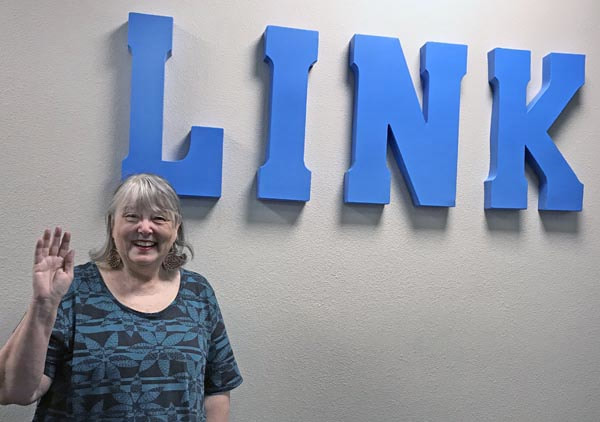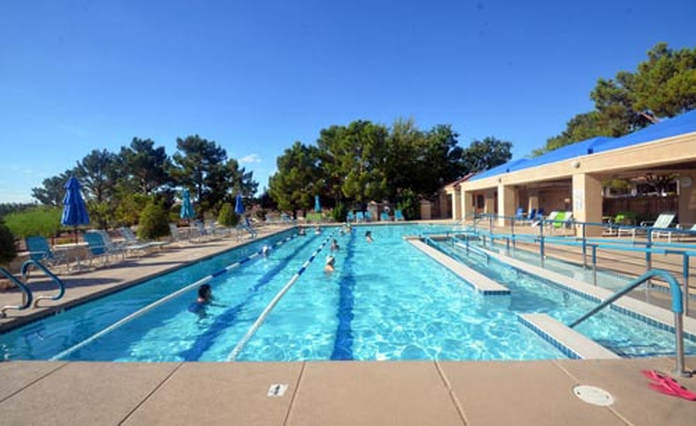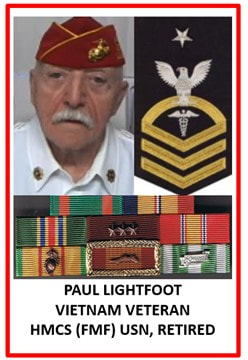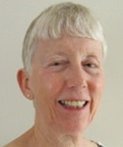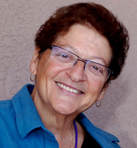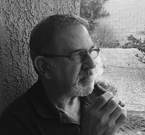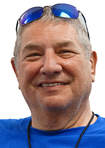Link Welcomes New Advertising Rep
When at Mountain Shadows, stop by the Link office and meet Sharon Bishop, who started as the magazine’s advertising coordinator on Monday. Sharon replaces Dianne Lowe, who worked at the Link for three and a half years. Sharon comes to the Link from the mailing, business and production side of publishing. She will take over all duties related to ad sales and billing, in addition to office responsibilities.
Art Club Show Set for Saturday & Sunday
Head to the Desert Vista Ballroom this weekend for the Art Club's annual spring show, "ArtWorks!" The fine arts event gets under way from 10 a.m. to 3 p.m., Saturday and Sunday. The showcase is a juried competition with an award's ceremony set for Saturday at 11 a.m. The event is a great place to meet club members and professional artists. Enjoy the artwork on display or purchase paintings in the popular Art Bin. Raffle prizes, refreshments and more are all part of the weekend event. The grand prize drawing will take place Sunday at 2:45 p.m.
Update From Mitzi: SCSCAI Budget Process Set to Start
The 2018/2019 budget process has begun. Budget hearings are scheduled as follows:
MONDAY, APRIL 9, 9 a.m. to 2 p.m.
WEDNESDAY, APRIL 11, 9 a.m. to 2 p.m.
FRIDAY, APRIL 13, 9 a.m. to 2 p.m.
The budget hearings will be held in the Desert Vista Community Center Ballroom, 10360 Sun City Blvd., and all residents are invited to attend. If you have ever wondered where the money you pay into the Association goes these are excellent meetings to attend.
MONDAY, APRIL 9, 9 a.m. to 2 p.m.
- Golf Pro Shops
- Golf Course Maintenance
WEDNESDAY, APRIL 11, 9 a.m. to 2 p.m.
- Landscape Maintenance
- Building Maintenance
- Administration
FRIDAY, APRIL 13, 9 a.m. to 2 p.m.
- Food and Beverage
- Security Patrol
- Community Services
- Fitness
- Link
The budget hearings will be held in the Desert Vista Community Center Ballroom, 10360 Sun City Blvd., and all residents are invited to attend. If you have ever wondered where the money you pay into the Association goes these are excellent meetings to attend.
Mitzi Mills, SCSCAI Executive Director
A Beautiful Day to Be at the Pool
Sun City celebrated the opening of its outdoor pools on Saturday, March 1. Desert Vista, Mountain Shadows and Pinnacle pools greeted residents and their guests as great weather was reported throughout the day. If you are a member of an aquatic club, check with your president to see when outdoor classes begin. If you plan to have visiting grandchildren, note that children’s hours are now in effect at the Mountain Shadows and Pinnacle pools, daily from 10 a.m. to 1 p.m.; at Desert Vista (indoor pool only), daily from 1 to 4 p.m. For your health and safety, always remember to shower before entering the community’s swimming pools.
Get the Conversation Started on Facebook

The Link magazine introduced its Facebook page last week, Facebook (Sun City Link Magazine), where residents can follow what’s going on in the community. Posts include short stories and videos on upcoming events and club activities. Link Social Media Coordinator Darlene Fadem is eager to hear from you and collect your comments on what keeps you busy in our beautiful community. If you are looking for a new way to promote your club, reach out to Darlene. Be sure to like the Link page and let's get the conversation started!
BOD to Hear Electronic Focus Group Plan
Plan to attend tonight's Board of Directors’ meeting at Desert Vista, 6 p.m., Room 5, where members of the Next Generation Sun City Summerlin research group will present recommendations for a strategic plan to help further actions aimed at enhancing our community. Click the link below to view the results of the research committee's questionnaire.
Continue Reading:
Thank You for Your Service -- Paul Lightfoot
Navy veteran Paul Lightfoot was assigned to the 3rd Preventative Medicine Unit, 3rd Medical Battalion, 3rd Marine Division. Paul’s main job was as an instructor in food services. His responsibilities took him all over the northern half of South Vietnam.
Whether on the barren slopes of Mount Suribachi, the frozen wasteland of the Chosin Reservoir or the mosquito-infected jungles of Vietnam, whenever a wounded Marine called “Corpsman Up,” a Navy corpsman was there. We’ve all seen it in hundreds of movies, but there is a lot more to being a Navy corpsman than being a battlefield doc. Take, for instance, the career of Sun City resident Paul Lightfoot.
Paul’s 20-year career started with a visit by a Navy recruiter at his high school in mid-state Illinois. He already had been accepted to pharmacy school at the University of Illinois, but that was really his parents' idea; Paul just wasn’t up for college at that point.
“So, when the recruiter told me that the Navy would make me a pharmacist, I was hooked,” he recalled. It took some doing to convince his parents, but he was 18 and, in the summer of 1957, he enlisted.
After completing boot camp, he got his promised assignment to Corpsman School at Naval Station Great Lakes. Sixteen weeks later, he began his on-the-job training at the Naval Hospital in Portsmouth, Virginia. There he would undergo two specialty rotations; medical/surgical and communicable disease. That was followed by yet another four months studying EKG and basal metabolism testing.
Next up, assignment to Camp Lejeune, North Carolina, the major Marine Corps base on the East Coast. And it was there, on New Year’s Eve 1960, that he met Patricia, the future-first Mrs. Lightfoot, who was a Wave (member of the Women’s Auxiliary) also serving as a corpsman. They married 21 days later. Soon pregnant, she left the service and Paul was sent to Guam for a three-year tour. She later joined him and their first two children were born there.
More education was to follow with Paul completing Instructors School.
“I really didn’t want to teach, but they made it pretty clear that I didn’t have much of a choice,” he said. But, he really liked it and after graduation taught for five years, 1963 to 1968.
Then even more education, as he was assigned to Preventive Medicine School in Oakland, Calif. By this time, they had four children and even as an E-7 he had to work nights at a McDonald’s to make ends meet. That was followed by Field Medical Service School at Camp Pendleton in Southern California. For a kid that didn’t want to go to college, Paul was getting a very thorough education!
But the year was 1969, the Vietnam War was raging, and it was time to put that education to work. Paul was assigned to the 3rd Preventive Medicine Unit, 3rd Medical Battalion, 3rd Marine Division. A modern military unit is somewhat akin to a small city. The troops had to be supplied and fed and that meant field kitchens, which, in turn, needed to be inspected. (Think “Dirty Dining” on Channel 13.) Paul’s main job was as an instructor in food services along with insect and rodent control. His responsibilities took him all over the northern half of South Vietnam.
Travel to the various fire bases was usually by lone Jeep, occasionally in a helicopter or swift boat and sometimes in a convoy.
“Some of those journeys were uneventful,” he recalled. “But others were not. One time three of us were driving to a forward fire base, FB Vandergrift. The route required us to ford three streams. We crossed the first two with no problem, although they did slow us down a bit. It was getting late but we decided to push on. We arrived at the third stream just as VC patrol were entering the area. They spotted us and a short fire fight ensued. I was in the passenger seat and had my M16 fully loaded. I emptied the clip as the driver hit the gas and we took off.
(CONTINUED FROM LINK, PAGE 32)
Fortunately, none of us were hurt. But it does show you how things could have changed if our timing was slightly different.
“Another time, an M.D. and I were part of a convoy that came under attack. We dismounted and used the vehicle as a screen. The doctor kept peeking up to see what was happening. I tried to convince him to keep his head down and finally he did after I said, ‘Doctor there are only us two medics here and these boys may be needing us when this is over. We must stay alive.’ That convinced him.”
There were numerous other instances where the old hand NCO had to advise newly arrived junior officers. Vietnam was a tough place for on-the-job training.
In November 1969, the 3rd Marine Division was withdrawn from Vietnam and sent to Okinawa, Japan. The division had been in Vietnam for four years and had lost 6,859 men killed in action (KIA).
Although the division is still based there, Paul’s stay was short. After three months of training local prostitutes in VD prevention, he was off to San Diego, Calif., to be followed by a tour in Oakland, Calif. By then, Paul had been promoted to senior chief (E-8). His hitch was nearing its end. The Navy elected to send him back to Okinawa; he elected to retire.
The retirement decision was made easier because his training in entomology gave him easy access to a new career in the pest control business, where he held a number of sales positions.
In 1993, he got married for the second time to Raquel Morales and they have been residents of Sun City Summerlin since 2003. Paul divides his time between website development and teaching Bible study classes via the Internet. He also preaches six or eight times every year at his church.
Paul’s 20-year career started with a visit by a Navy recruiter at his high school in mid-state Illinois. He already had been accepted to pharmacy school at the University of Illinois, but that was really his parents' idea; Paul just wasn’t up for college at that point.
“So, when the recruiter told me that the Navy would make me a pharmacist, I was hooked,” he recalled. It took some doing to convince his parents, but he was 18 and, in the summer of 1957, he enlisted.
After completing boot camp, he got his promised assignment to Corpsman School at Naval Station Great Lakes. Sixteen weeks later, he began his on-the-job training at the Naval Hospital in Portsmouth, Virginia. There he would undergo two specialty rotations; medical/surgical and communicable disease. That was followed by yet another four months studying EKG and basal metabolism testing.
Next up, assignment to Camp Lejeune, North Carolina, the major Marine Corps base on the East Coast. And it was there, on New Year’s Eve 1960, that he met Patricia, the future-first Mrs. Lightfoot, who was a Wave (member of the Women’s Auxiliary) also serving as a corpsman. They married 21 days later. Soon pregnant, she left the service and Paul was sent to Guam for a three-year tour. She later joined him and their first two children were born there.
More education was to follow with Paul completing Instructors School.
“I really didn’t want to teach, but they made it pretty clear that I didn’t have much of a choice,” he said. But, he really liked it and after graduation taught for five years, 1963 to 1968.
Then even more education, as he was assigned to Preventive Medicine School in Oakland, Calif. By this time, they had four children and even as an E-7 he had to work nights at a McDonald’s to make ends meet. That was followed by Field Medical Service School at Camp Pendleton in Southern California. For a kid that didn’t want to go to college, Paul was getting a very thorough education!
But the year was 1969, the Vietnam War was raging, and it was time to put that education to work. Paul was assigned to the 3rd Preventive Medicine Unit, 3rd Medical Battalion, 3rd Marine Division. A modern military unit is somewhat akin to a small city. The troops had to be supplied and fed and that meant field kitchens, which, in turn, needed to be inspected. (Think “Dirty Dining” on Channel 13.) Paul’s main job was as an instructor in food services along with insect and rodent control. His responsibilities took him all over the northern half of South Vietnam.
Travel to the various fire bases was usually by lone Jeep, occasionally in a helicopter or swift boat and sometimes in a convoy.
“Some of those journeys were uneventful,” he recalled. “But others were not. One time three of us were driving to a forward fire base, FB Vandergrift. The route required us to ford three streams. We crossed the first two with no problem, although they did slow us down a bit. It was getting late but we decided to push on. We arrived at the third stream just as VC patrol were entering the area. They spotted us and a short fire fight ensued. I was in the passenger seat and had my M16 fully loaded. I emptied the clip as the driver hit the gas and we took off.
(CONTINUED FROM LINK, PAGE 32)
Fortunately, none of us were hurt. But it does show you how things could have changed if our timing was slightly different.
“Another time, an M.D. and I were part of a convoy that came under attack. We dismounted and used the vehicle as a screen. The doctor kept peeking up to see what was happening. I tried to convince him to keep his head down and finally he did after I said, ‘Doctor there are only us two medics here and these boys may be needing us when this is over. We must stay alive.’ That convinced him.”
There were numerous other instances where the old hand NCO had to advise newly arrived junior officers. Vietnam was a tough place for on-the-job training.
In November 1969, the 3rd Marine Division was withdrawn from Vietnam and sent to Okinawa, Japan. The division had been in Vietnam for four years and had lost 6,859 men killed in action (KIA).
Although the division is still based there, Paul’s stay was short. After three months of training local prostitutes in VD prevention, he was off to San Diego, Calif., to be followed by a tour in Oakland, Calif. By then, Paul had been promoted to senior chief (E-8). His hitch was nearing its end. The Navy elected to send him back to Okinawa; he elected to retire.
The retirement decision was made easier because his training in entomology gave him easy access to a new career in the pest control business, where he held a number of sales positions.
In 1993, he got married for the second time to Raquel Morales and they have been residents of Sun City Summerlin since 2003. Paul divides his time between website development and teaching Bible study classes via the Internet. He also preaches six or eight times every year at his church.
Bob Cohen/Link

